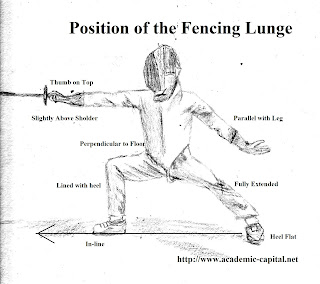 The fencing lunge is a basic footwork attack using the three main
categories of the foil, saber, and epee. The lunge is a fundamental attack and
is characterized by pushing both the front foot and arm forward in an attempt
to strike your opponent. With additional blade skills the lunge can be
adjusted to create variety of movements from the basic forward motion. To
complete the lunge well requires hours of practice but will improve your
overall competitive game.
The fencing lunge is a basic footwork attack using the three main
categories of the foil, saber, and epee. The lunge is a fundamental attack and
is characterized by pushing both the front foot and arm forward in an attempt
to strike your opponent. With additional blade skills the lunge can be
adjusted to create variety of movements from the basic forward motion. To
complete the lunge well requires hours of practice but will improve your
overall competitive game.
Basic Motion:
From the en garde position the front foot is moved forward
from the knee without bending the ankle. The movement of the front leg occurs
before the weight of the body is shifted creating less notice to the
opponent. The back leg is used to push
the body forward and the rear arm is outstretched downward in order to create a
counter balance. The front foot slides into position as the weapon arm is
outstretched to strike the target. The front shin should be perpendicular to
the ground and both heals firmly planted.
The lung represents everything that is beautiful about
fencing. With additional practices and learning of various blade skills the
lunge becomes an extremely powerful move. It can be explosive in the sense that
seasoned fencers are able to leap large distances in a relatively short
time-frame that catches their opponent off garde and unable to counter the
power of the attack.
Defense of Lunge:
The best defense for the lunge is to be prepared for the
attack. This occurs by watching the body movement, mechanics, and footwork. An
opponent cannot make an effective lunge between steps and is unlikely to have
enough power unless their body mechanics are in proper arrangement prior to the movement. Since the
lunge is not designed for accuracy the opponent will typically attempt to
strike your torso. Thus moving your body slightly inside will throw off the
attack. Likewise, quickly reclaiming the right-a-way and allowing the opponent
to push themselves into your blade works well.
The Ending Stance:
The forward arm should be fully extended and slightly above
the shoulder. The forward knee should be directly above the heel while the
back leg should be extended to its full length with the heel to the ground and
the toes perpendicular to the line of the body. The rear arm should be in parallel
with the angle of the rear leg. The thumb holding onto the blade should be on
top of the grip while the fingers are on the bottom so that the wrist may bend
to find its target. In a perfect world
the blade is parallel with the ground to create maximum reach. However, this
depends on the movement and height of the target.
Author: Dr. Murad Abel
No comments:
Post a Comment